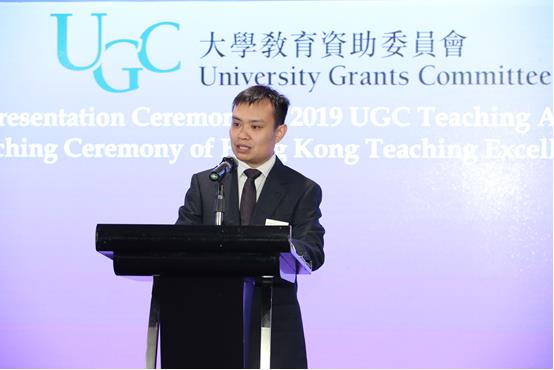Acceptance Speech by Professor Darwin Tat Ming Lau at the Presentation Ceremony of the 2019 UGC Teaching Award (10.10.2019)

It is a great honour to be presented with the UGC Teaching Award. I would like to thank the UGC and the panel of adjudicators for their vote of confidence. Let me also thank the Chinese University for nominating me.
Teaching is a job as challenging as it is meaningful. It is challenging as you have to motivate your students to learn in a world that is changing very fast. When my teachers were students, teaching was quite unilateral. Today, teachers are encouraged to be student focused and foster peer learning, but in my opinion our students not only need teachers and peers, but also need active and experiential learning to reinforce what they have learnt. This approach is called the Student-Teacher-Experience-Peer learning modality.
'Experience' represents a hands-on or experiential feedback element. The feedback element can be anything that students can work on. As I teach robotics, the feedback element is of course a robot. To maximize students' contact with the experiential element, and experiential element, or robots, are present within the lectures, projects, and even in outside classroom activities.
Through the Student-Teacher-Experience-Peer modality. I want to increase my students' learning effective, motivation and passion, to help them realize the relevance of what they've learnt to the real world, and encourage them to use their skills to innovate and benefit society.
To accomplish my teaching goals, I make sure my hands-on lectures are enjoyable and memorable. During such lectures, students learn in groups of four or five, and each group is given a real robot arm. There are frequent hands-on exercises involving the robot arm to engage the students' attention. By performing the exercises and overcoming challenges, students can have a better grasp of abstract concepts. The robots also help students identify the concepts they find difficult, and teachers can assist students who appear to be lagging behind.
Also, I encourage my students to move beyond the classroom and put what they've learnt into practice in the real world. My students participate in team robotic competitions and practical hands-on projects, such as developing affordable prosthetic devices for amputees in collaboration with the Prince of Wales Hospital. These projects not only give students the opportunity to hone their engineering skills, but also help them become more civic-minded and socially responsible.
Of course, the Student-Teacher-Experience-Peer mixed mode teaching is not limited to mechanical engineering; it can be used in other disciplines as well. The success of the approach hinges on increasing students' exposure to a feedback carrier that allow students to perform hands-on tasks with directly observable results. The course syllabus and lecture materials should be adapted to achieve seamless integration with the hands-on experiential learning element.
Beyond educating university students, I believe we have to engage the future generations and arouse their interest in engineering. That's why I have been promoting engineering to secondary school students by teaching summer courses, giving guest presentations, and organizing university visits and workshops.
The famous writer William Arthur Ward said, 'The mediocre teacher tells. The good teacher explains. The superior teacher demonstrates. The great teacher inspires.' I really hope that my teaching and learning activities can inspire current and future students, and this is what keeps me going.
Through the award grant, I plan to further enhance the experiential element by developing a 'student-driven course', where a mobile application designed for the course, telepresence robots, augmented reality and real-time feedback will be used to improve student learning outcomes and experiences.
Finally, I would like to extend my hearty thanks to my TAs and students. My TAs have been most helpful; without them, it would be impossible to successfully execute mixed mode teaching. And I thank my students for their feedback and encouragement. The teaching award is less a tribute to me than to all those who have put their efforts into the Student-Teacher-Experience-Peer mixed mode teaching with the goal to improve our students' learning experience. It is also a good reminder that hard work will always pay off.
Thank you.